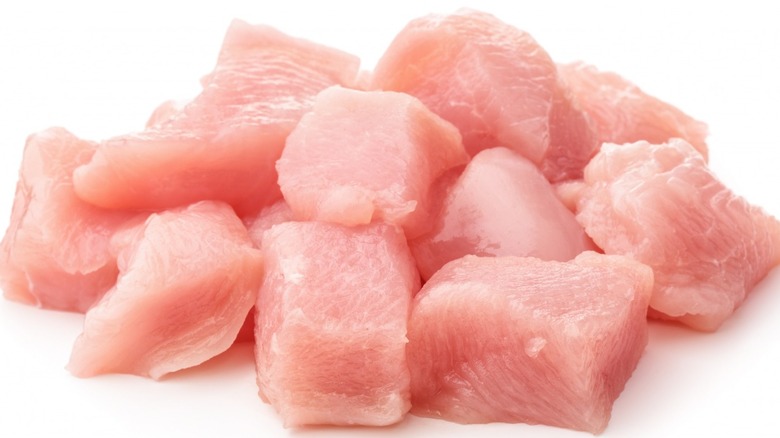Why You Should Cut Chicken Into Even Sizes Before Cooking
Ever cook a recipe, follow all the instructions exactly, and still not have it come out tasting like what you remember? While sometimes this can be chalked up to quality, freshness, or ripeness of ingredients — or even the stove or oven you're cooking with — it can also have to do with the size and uniformity of the pieces of food you're working with. Anyone who's ever seen Gordon Ramsay instructing newbies in Hell's Kitchen knows that he, like most other chefs, is a stickler about uniformity in knife cuts. And while this skill is as important (for a variety of reasons) for veggies in mirepoix (carrots, celery, and onions), as it is for cheese, fresh herbs, and even salad ingredients, it can be especially crucial when it comes to cooking chicken. While there are plenty of myths surrounding chicken, size isn't one of them.
There's a variety of reasons why uniform sizing of ingredients is advantageous when cooking, from maintaining the balance of flavors throughout a dish and more accurate cooking times, to more consistent outcomes in texture, taste, and presentation. NPR notes, " . . . cut affects texture, which some food experts believe affects flavor — or at least our perception of flavor." Not only do evenly-sized ingredients allow for greater visual appeal but as MasterClass points out they'll also help your food to cook at a more even rate, as larger pieces take longer to cook than smaller pieces. And when it comes to cooking chicken, even cuts are crucial.
Cutting chicken: Why size is important
Michelin Guide states, "Uniform cuts are not only great for presentation, but they also ensure that every piece of food cooks evenly together." This is something that becomes even more important when you're cooking an ingredient that has the potential for salmonella if undercooked.
Dietitian Jenna Volpe, RDN, LD told Livestrong, "Trying to cook different-sized pieces of chicken at the same temperature and for the same amount of time will likely result in some pieces of chicken that are overcooked, and other pieces that are undercooked." The Centers for Disease Control and Prevention, warns that raw chicken is not only subject to Salmonella but also lesser-known bacteria: Campylobacter and Clostridium perfringens. All three of these can remain present in the juices of raw or undercooked chicken, and they may lead to foodborne illness or infection. By cutting your chicken pieces uniformly, you'll not only ensure the taste, texture, and presentation of your chicken will be spot-on, but you'll also know that if you temp one piece of chicken and it's done, it's likely that all are fully cooked and consistent with safety guidelines.

